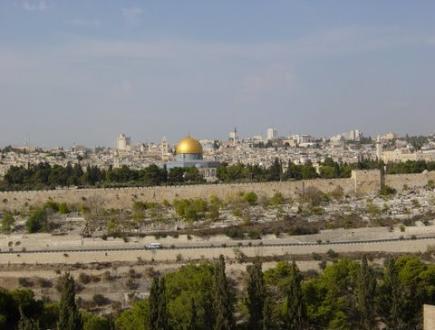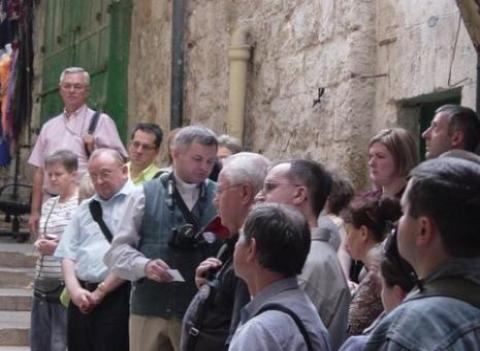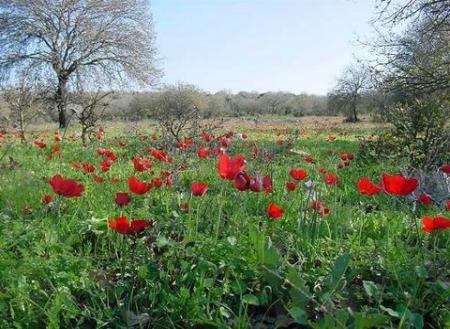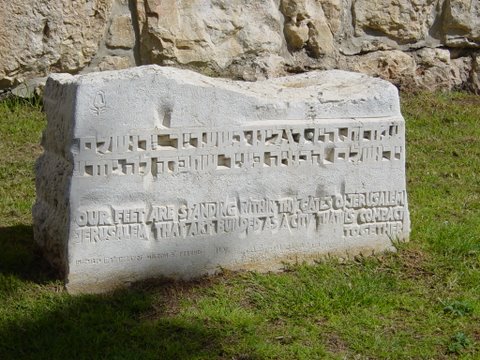-1-
Israel’s Amazing Uniqueness
How can a little country some fifty miles wide and a mere one-hundred-fifty miles long keep the world in an uproar all the time? How can tiny Israel be the constant focus of world news reports, and why should such a small place have the second largest concentration of news bureaus in the world? 1 Why should the little mountain town of Jerusalem always get a lion’s share of world publicity?
Jerusalem’s old and new cities
How can the Israeli people, numbering less than seven million, be considered such a mortal threat to the approximately 300 million heavily-armed Muslims in the Middle East? And why would such an august body as the United Nations spend a third of its time dealing with little Israel? 2
These things all seem preposterous, but they certainly attest to Israel’s amazing uniqueness as a nation. For instance, just “down the road” from Jerusalem is the great city of Cairo and the country of Egypt. Cairo, the largest city in Africa, has over seventeen million people, yet it is rarely mentioned on the evening news. However, almost daily we hear of Jerusalem, whose population is less than three quarters of a million people. The world’s news bureaus do not jostle each other for space in Cairo or in Egypt. The city and country have been of little concern to the United Nations.
ISRAEL, AN INCREDIBLY TINY PLACE
The nation of Israel and its capital city of Jerusalem are minuscule in comparison with other nations and cities of the world. When compared to the US, Israel is about the size of the little state of New Jersey. The nation of France could hold twenty-six nations of Israel.
Of course, Israel should rightly be compared with countries in her own neighborhood, the Middle East. It is shocking when we realize that the Middle East nations of the Arab League are spread over five million square miles, while Israel consists of less than 8,000 square miles. 3
Israel is so small that one can easily drive from the biblical border cities of Dan in the north, to Beersheba in the south, in half a day. We have cause to pity the Israeli jet pilots, who in a few careless moments of maneuvers could find themselves flying over hostile Syria or Saudi Arabia.
Israel is tiny, but the nation possesses a geographic, political and spiritual importance far out of proportion to its size.
CROSSROADS OF THE WORLD
Israel not only commands a disproportionate amount of media coverage, but the land is a veritable crossroads of the world, connecting the continents of Europe, Asia and Africa.
In ancient times, people and armies traveled over the roads situated in what is known as the Fertile Crescent. This strip of fertile land ran from Egypt to the other great centers of Assyria and Babylonia. This ancient super-highway system ran directly through Israel. Thus the great nations of the Middle East always struggled between themselves for
this passageway.
One famous ancient route was the Way of the Sea (Via Maris) mentioned in Isaiah 9:1-2, and also in Matthew 4:15-16. This ancient road ran through Capernaum where Jesus established a base for his ministry. The prophet Isaiah, who lived in the eighth century BC, prophesied that a bright light would shine along this highway.
Israel was not only a land bridge from north to south, but also from east to west. Many ancient caravans bearing spices and other items from the east, traveled through the general area. Also, from the time of Solomon, Israel had periodic access to the Far East via the Gulf of Aqaba and the Red Sea.
Even today, Israel is still a world crossroads. People from almost every nation live in the country and millions more visit it. The Jews themselves have returned home from more than one hundred nations. On a bus ride, or a stroll through the park, one may see people reading newspapers from virtually every corner of the world.
Pilgrims from all over the world come to Israel
The Jerusalem taxi drivers have the very difficult task of communicating with people from every language background. It often seems that as soon as passengers open their mouths, the drivers are able to communicate in the necessary tongues.
Israel is not just a crossroads for people, but one for birds as well. For instance, twice each year, in spring and again in the fall, millions of birds pass over Israel, as they make their trips to and from Europe, Asia and Africa. In all, there are 121 species of migratory birds, plus another 94 species that come to spend the winter in Israel. There are honey buzzards, storks, pelicans and many more winged visitors. 4 Some of these birds love Israel so much that they decide to stay, much to the chagrin of fish farmers.
LAND OF AMAZING BEAUTY AND DIVERSITY
The Bible assures us that Israel is the most beautiful land in all the earth. In Ezekiel 20:6 we read:
On that day I swore to them that I would bring them out of Egypt into a land I had searched out for them, a land flowing with milk and honey, the most beautiful of all lands.
The physical setting of Israel is not just beautiful, but it is also extremely interesting and diversified, as we read in Deuteronomy 8:7-9:
For the LORD your God is bringing you into a good land—a land with streams and pools of water, with springs flowing in the valleys and hills; a land with wheat and barley, vines and fig trees, pomegranates, olive oil and honey; a land where bread will not be scarce and you will lack nothing; a land where the rocks are iron and you can dig copper out of the hills.
Israel has a vast diversity in its terrain. There is cool, snow-capped Mount Hermon in the north, reaching to an elevation of 9,232 ft. (2,841 m.), and there are the blistering semi-deserts of the Negev in the south. Also, in contrast with the heights of Hermon are the depths of the Jordan Rift and the Dead Sea. This body of water marks the lowest habitable spot on earth, at 1,312 ft. (404 m.) below sea level.
Israel also enjoys a great variety in climate. When Jerusalemites are shivering in the winter cold, they can take comfort in the fact that they are a mere thirty-minute drive from semi-tropical Jericho, and the warm resorts at the Dead Sea.
Since Israel borders on three deserts, much of the area to the east of its central chain of mountains is desert of some type. This desert runs from the areas around Jericho to the Dead Sea, on to The Wilderness of Zin and then to Eilat.
Wilderness area in the Negev
The amount of rainfall in the country ranges from about 60 inches (152 centimeters) per year on Mt.Hermon in the north, to less than an inch (2.5 centimeters) for Eilat in the south. 5 The central mountains of Israel may be blasted with snow and cold in the winter months, and yet may swelter with an early spring heat wave. The heat wave, or sharav, blowing in from the desert can quickly drive temperatures into the 90 degree F.
range ( 32 C.).
In Deuteronomy 6:18, Israel is referred to as ha-eretz ha-tovah, or “the good land.” Then again in Psalm 106:24, the Psalmist refers to Israel as “the pleasant land.” Even in the hot summer, there are cool, pleasant breezes that come up from the Mediterranean in the afternoon. In the winter, even cities with the highest elevations like Jerusalem and Zefat, seldom see temperatures drop below freezing. Roses usually bloom all winter in Jerusalem. There are no tornadoes or hurricanes.
DIVERSITY OF FLORA AND FAUNA
The uniqueness of Israel really becomes apparent when we look at the country’s flora and fauna. Because of Israel’s geographic position, linking three continents, there is an amazing variety of plant and animal life. For instance, within the tiny land of Israel there are five distinct vegetation zones. This great variety of life has perplexed naturalists as they have labored to make the proper classifications.
Poppies blooming on the Golan
Lambert states, “The rich variety of vegetation zones, make it the meeting ground of plants native to widely differing parts of the earth, plants with such differing origins as Siberia, Western Europe, Inner Asia, North Africa and East Africa.” 6
Israel at present has some 2500 plant types. For the sake of comparison, Egypt with its rich Nile Delta has only 1500. Britain has 1700, and Norway has 1335. “No other place in the world has such floral wealth concentrated within such a comparatively small area.”7
For instance, in the Hula swampland one might find the tropical papyrus plant flourishing. Papyrus is an African plant and Israel is as far north as it grows. 8 Or at Ein Gedi on the Dead Sea one might see the Moringa tree, which is a native of Sudan. In the Jordan Valley alone there are some forty varieties of tropical flora.
In the southernmost tip of Israel at Eilat, the visitor is treated to a magnificent desert climate with its special vegetation. For instance, the Doum Palm (Dome Mitzri – Hyphaene thebaica), normally found in Sudan, grows around Eilat. 9 The Doum Palm has a distinguished look with a trunk that forks out about mid-way up giving it the appearance of having two horns.
Numerous animals have ventured in from Africa in the south, or from Syria and points further in the north and have made Israel their home. For instance, the land of Israel marks the southernmost limit in the range of the Siberian wolf. The little coney has come up to Israel from Africa, and Israel and Syria mark its northernmost limits. Israel also has about twenty-five species of bat, from the three continents of Europe, Asia and Africa. 10
A young Ibex from the Ein Gedi area
At Eilat, the visitor will see what has been called “one of the three richest coral reefs in the world.” 11 From Eilat’s underwater observatory one can see a vast array of colorful tropical fish in their natural habitat. A trip to Eilat is a thrilling and unforgettable experience.
Some of the colorful fish and coral at Eilat
SPIRITUAL UNIQUENESS
Israel is certainly unique in the natural sense, because of its size, location and diversity of climate and wild life. However, its greatest uniqueness is in the spiritual realm. We see this clearly reflected in the pages of the Bible. The Bible, after all, is our guide and authority, not only in matters of theology, but in matters of our everyday lives.
For centuries, preachers and biblical expositors have realized that the frequency of words found in the scripture gives us some indication as to the importance of the subjects. As an example, Christianity rests upon three pillars, as Paul tells us in 1 Corinthians 13:13. The pillars are faith, hope and love. When we check out the frequency of these words in the Authorized Version of the Bible, we find that faith appears 257 times, and hope appears 129 times. Love, being the most important of the three, appears 310 times. This is a respectable amount of appearances.
However, when we check out the occurrence of “Jerusalem” in scripture we may be amazed to learn that it appears 811 times – more than faith, hope and love combined. Jerusalem is just one of the many names the city is called in scripture. Also, when we search under the subject of “Israel,” we may be shocked to find that it appears 2565 times. We should realize by this that “Jerusalem” and “Israel” are subjects very close to the heart of God.
In the scripture, the expression “God of Israel” appears over 200 times. This is only one of several expressions like “God of Jacob,” and “God of Abraham,” which connect the God of the universe closely with the Jewish people and the land of Israel. These are names by which God wishes to be known. However, these names are deemed “not politically correct” by many in our day.
In the Bible, we read about God’s great attachment to the land of Israel. In Deuteronomy 11:12, we learn that “It is a land the LORD your God cares for; the eyes of the LORD your God are continually on it from the beginning of the year to its end.”
We learn in the Bible that Israel is central in God’s plan for the earth. In Ezekiel 38:12, it is mentioned that the land of Israel is at the very center of the earth. The Hebrew word used here is tabbuwr, and in modern Hebrew it means “navel” or “bellybutton.” The earth does have a navel, a place where the umbilical cord between heaven and earth was once attached. In Revelation 21:1-4, the Bible indicates that it will someday be re-attached as this world undergoes a re-creation.
In Psalm 76:1 we read, “…In Judah God is known; his name is great in Israel.” For thousands of years, God has been busy building a salvation infrastructure in the land of Israel. He has done this so that peoples and nations the world over may fully know him.
In a real sense, “…He has set his foundation on the holy mountain…” (Psa. 87:1). God had to establish the patterns, types, and pictures that would help us understand his great salvation. For instance, the Tabernacle and Temple with all their rites help us understand the sacrifice of Jesus. Without these pictures we would be at a total loss to understand.
Jerusalem, being the very center or hub of God’s redemptive activity, is extremely important to him. We read in Isaiah 49:16, “See, I have engraved you [Jerusalem] on the palms of my hands; your walls are ever before me.”
Israel and its capital city of Jerusalem are certain to be the focus of last-day activity. This will transpire as sinful man and his systems collide head-on with God and his coming kingdom. We are assured in scripture that God will gather all nations to Jerusalem for battle (Zech. 14:2). At that time the Lord will fight for Israel and afterward the nations of the earth will know that the Lord is God.
CLAIMED BY THE WORLD’S LARGEST RELIGIONS
To illustrate her great spiritual importance, Jerusalem is claimed jointly by the religions of Judaism, Christianity and Islam. These claims apply not only to Jerusalem but also to most other parts of the land. Since these religions include more than three billion people, we can see that Jerusalem and Israel are extremely important to half the world’s population.
Jerusalem has long been the focal point of Jewish aspirations. Over the centuries the Passover seder has ended with the longing and hopeful words, “Next year in Jerusalem!”
The Jewish National Anthem, Ha Tikva, by Naphtali Herz Imber, also expresses that eternal hope within the Jewish heart in these words translated into English:
As long as in depth of the heart a Jewish soul is yearning, and towards the east an eye is still looking to Zion, our hope is not lost yet, the 2000-year-old hope to be a free nation in our land, the land of Zion and Jerusalem.
In addition to being at the very heart of the Jewish faith, Jerusalem is the cradle of Christianity. The dramas of the birth, death and resurrection of Jesus all took place in the general area of Jerusalem. The Church of the Nativity in the city of Bethlehem marks the place of Messiah’s birth. This city, which is now a part of the Palestinian Authority, is still practically a suburb of Jerusalem. The twin sites, the Church of the Holy Sepulcher in Jerusalem’s Old City, and the Garden Tomb just outside the north city wall, both mark possible places of the death, burial and resurrection of Jesus.
Calvary, inside the Church of the Holy Sepulcher
In modern times, the dark clouds of political turmoil have increased over Israel and Jerusalem. This has been especially true as the Jews have returned home from the nations. Because of Muslim political aspirations concerning the land, Jerusalem and Israel have taken on an increased importance to Islam.
Although Jerusalem’s Temple Mount has been the location of the Dome of the Rock and Al Aksa Mosque since the seventh century, Jerusalem was a “backwater” so far as its importance to Muslims until the twentieth century. For instance, in the thirteen hundred years that Islam exercised general domination over Israel, Jerusalem was never a Muslim capital city or even an administrative center. The administrative center was at Ramle near the coast.
Today, because of the increasing political struggle over Jerusalem, Muslims are flocking in greater numbers to the Temple Mount for prayer and pilgrimage, although prior to the twentieth century the Temple Mount had not been a place of Muslim pilgrimage. 12 Thousands of Muslims now gather to the area on Fridays for weekly prayers. The religious struggle over the Temple Mount has greatly intensified in recent years, with occasional flare-ups of violence as Jews and Muslims worship in close proximity.
SITE OF PILGRIMAGE SINCE ANCIENT TIMES
The Jewish people have made pilgrimage to Jerusalem since ancient times. According to Jewish law, each male was required to come to Jerusalem every year for the three major festivals of Passover (Pe-sach), Pentecost (Sha-vu-ot) and Tabernacles (Suk-kot) (Ex. 23:17). Since Jerusalem sits astride the mountain ridge running through the country, it was necessary to climb up to Jerusalem. The trip was dangerous and difficult. It often had to be done on foot and in the heat of the sun.
A pilgrim Psalm engraved on stone at Jerusalem’s Old City
In our Bibles we still have recorded many songs that were undoubtedly sung by pilgrims as they ascended to the city and to the Temple Mount. They were also used in Temple worship at certain times. These “Songs of Ascents,” or of “going up,” are very descriptive of the journey. They begin with Psalm 120 and continue through Psalm 134.
It is interesting today that the process by which one becomes a citizen of modern Israel is called “making aliya.” In Hebrew it simply means “going up.”
A Psalm of “going up” Psalm 121:1-8
1 I lift up my eyes to the hills—where does my help come from?
2 My help comes from the LORD, the Maker of heaven and earth.
3 He will not let your foot slip—he who watches over you will not slumber;
4 indeed, he who watches over Israel will neither slumber nor sleep.
5 The LORD watches over you—the LORD is your shade at your right hand;
6 the sun will not harm you by day, nor the moon by night.
7 The LORD will keep you from all harm—he will watch over your life;
8 the LORD will watch over your coming and going both now and forevermore.
In the Book of Acts we learn that great numbers of Jewish pilgrims had come to the Feast of Pentecost from many different parts of the world. After witnessing the outpouring of the Holy Spirit these pilgrims replied:
Then how is it that each of us hears them in his own native language? Parthians, Medes and Elamites; residents of Mesopotamia, Judea and Cappadocia, Pontus and Asia, Phrygia and Pamphylia, Egypt and the parts of Libya near Cyrene; visitors from Rome (both Jews and converts to Judaism); Cretans and Arabs—we hear them declaring the wonders of God in our own tongues! (Acts 2:8-11).
In the fourth century, after Christianity was finally established as the religio licita in the Roman Empire, Christian pilgrims began to make their appearance in Jerusalem. Even Emperor Constantine’s mother, Helena, became a pilgrim in the fourth century AD. It was due to her influence that some of the great churches were built, such as the Church of the Holy Sepulcher and the Church of the Nativity.
Another pilgrim in the latter part of the fourth century was named Egeria. Archaeologists and Bible scholars still use her written accounts to try and piece together the locations of authentic biblical sites. What a shame it is that many other pilgrims did not visit the land and heed the command of Psalm 48:12-13:
Walk about Zion, go around her, count her towers, consider well her ramparts, view her citadels, that you may tell of them to the next generation.
Today, millions of modern pilgrims journey by airliner to Israel and then travel by luxurious air-conditioned buses throughout the land. They know few of the hardships of pilgrims in earlier times. However, they are pilgrims nonetheless, with their notepads, recorders, cameras and videos. It is interesting that the bulk of these pilgrims
are Christians.
Modern tourists capture Old Jerusalem on film
A visit to the land is important for Christians. The land of Israel has often been called “the fifth gospel.” There are four gospels we can read anywhere in the world, but one we can only experience by a visit to Israel. This “gospel” quickly brings the other four gospels into perspective. It does the same for the rest of the Bible. As one enlightened visitor remarked, “I used to see the Bible only in black and white – now I see it in living color.”
When one travels about the land, the stories of the Bible come to life. Almost everywhere one looks or walks in Israel, there is a contact made with the Bible and history. One may drive past Rachel’s Tomb near Bethlehem and be reminded that there she died while giving birth to her son Benjamin (Jer. 31:15; Matt. 2:18). One may see the Temple complex and suddenly realize the accuracy of Jesus’ prophecy that one of those original stones would not be left upon another on top of this Temple platform (Matt. 24:2).
The land of Israel is no doubt the World’s biggest “show-and- tell.” God designed it that way so that we can picture the mysteries of his kingdom.
As millions of pilgrims arrive in Israel and as Israel and Jerusalem come more and more into the spotlight of the world media, we need to reflect much upon Israel’s great significance. If we believe the Bible we must admit that Israel, with its heart in Jerusalem, is God’s project. It is an age-old project.
In all the ages God has had only one plan, and that plan is that his glory and his salvation should go forth from Israel to all nations. As one old preacher said, “God plans his work and works his plan.” God has never had to change his plan, because he knew the end from the beginning. All this gives Israel and Jerusalem a uniqueness not possessed by other nations or cities. Israel and Jerusalem are truly unique in that they are central in God’s great plan for the earth. God himself says:
Remember the former things, those of long ago; I am God, and there is no other; I am God, and there is none like me. I make known the end from the beginning, from ancient times, what is still to come. I say: My purpose will stand, and I will do all that I please (Isa. 46:9-10).
STUDY QUESTIONS:
Give some reasons why God chose the physical land of Israel as a base for his redemptive work.
Is it still important for Christians to visit Israel and Jerusalem in this modern day?
If so, why?
Give two reasons why it might be beneficial to pray for Jerusalem (Psalm 122:6-9).
Why might Israel and Jerusalem become a “bone of contention” to nations and peoples in the future?
NOTES
1. Ramon Bennett, Philistine- The Great Deception (Jerusalem: Arm of Salvation, 1995)
p. 181.
2. See Editorial, “The UN Impediment,” The Jerusalem Post, 9 June, 1991.
3. Leonard Davis, Myths and Facts, A concise Record of the Arab-Israeli Conflict (Washington, DC: Near East Report, 1984) pp. 248-49.
4. See “Birds of Passage Pass Over,” Dispatch From Jerusalem, September/October,1995, p. 9.
5. Facts About Israel (Jerusalem: Ministry of Foreign Affairs, Information Division, 1985), p. 5.
6. Lance Lambert, The Uniqueness of Israel (Eastbourne: Kingsway Publications Ltd., 1980) p. 20.
7. Goeffrey Wigoder, Israel Pocket Library, Geography (Jerusalem: Keter Publishing House Jerusalem Ltd, 1973) p. 137.
8. Azzaria Alon, Flowers and Trees of the Holy Land (Printed in the Holy Land: Palpot Ltd.,) p. 31.
9. Uzi Plitman, Clara Heyn, Avinoam Danin and Avishai Shmidah, Plants in Israel, trans. from Hebrew (Masada, Israel 1983) p. 260.
10. Lambert, The Uniqueness of Israel, p. 24.
11. Lambert, The Uniqueness of Israel, p. 25.
12. Eliyahu Tal, Whose Jerusalem (Jerusalem: International Forum for a United Jerusalem, 1994) p. 74









